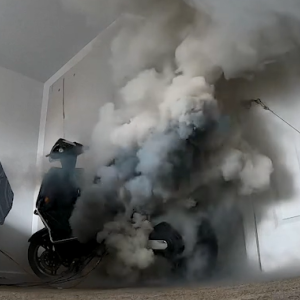
FSRI Examines the Impact of a Residential Sprinkler System During E-Mobility Device Experiments
The growing prevalence of lithium-ion battery powered e-mobility devices, like e-scooters, presents new safety challenges for the fire service and device owners. If these batteries go into thermal runaway, they can catch fire or cause an explosion. When that happens, the room where the device is located can become engulfed in flames and experience flashover in less than a minute, giving occupants very little time to escape on their own.
The rapid growth rate of fires caused by thermal runaway in a lithium-ion battery powered e-mobility device, when compared to other residential fire sources, can lead to severe and possibly fatal thermal and toxic exposures prior to fire service intervention. These threats have led the fire service to a call for solutions from researchers and manufacturers to mitigate these unique hazards of lithium-ion battery fires.
In April 2023, the Fire Safety Research Institute (FSRI), part of UL Research Institutes conducted a series of experiments to test whether a residential sprinkler system can limit the growth of lithium-ion battery powered e-mobility device fires. For the experiments, FSRI collaborated with the National Fire Sprinkler Association (NFSA) to utilize a sprinkler system that follows the code requirements and design standards for residential structures.
"We’re looking at whether residential sprinklers can have a positive impact on controlling the rate and extent of e-mobility device fire hazards. If they do, it makes a strong case for why we need residential sprinklers. If they don’t, it demonstrates that design scenarios used in code requirements may need to be updated to account for e-mobility devices.”
—Adam Barowy, research engineer, FSRI
This series of experiments examines the effect a residential sprinkler system following NFPA 13D design standard has on e-mobility device fires within a residential structure. A total of five tests were conducted as part of the series:
- Two tests involved intentionally overcharging an e-scooter battery to induce thermal runaway while the e-scooter was positioned in a closed bedroom.
- Two tests involved intentionally overheating an e-scooter battery to induce thermal runaway while the e-scooter was positioned in a closed bedroom.
- One test involved intentionally overcharging an e-scooter battery to induce thermal runaway while the e-scooter was positioned in a living room.
Residential sprinklers are designed to spray water outward at the walls to a point about 12 inches below the ceiling. This process wets the wall surface and other fuel sources within the room of origin to limit flashover. The sprinklers used during the experiments automatically activated when the sprinkler was exposed to gas temperatures of 155ºF and above. Water flowed for ten minutes at a rate of 13-18 gallons per minute. Following full suppression of each test, FSRI research engineers evaluated the extent of damage within the compartment to determine how the sprinklers limited fire growth.
“NFSA is proud to work with FSRI on these experiments. Fire sprinklers buy time and time buys life which is essential to occupant and firefighter survivability.”
—Shane Ray, president, NFSA
The goal of a residential sprinkler system is to prevent flashover by limiting fire growth. Throughout the series of experiments, FSRI consistently observed that while the room of origin was damaged, sprinklers did not allow flame spread to secondary items and ultimately prevented flashover. Detailed thermal and toxic analysis is underway and will be published with a technical report that assesses the fire dynamics associated with thermal runaway of e-mobility devices.



